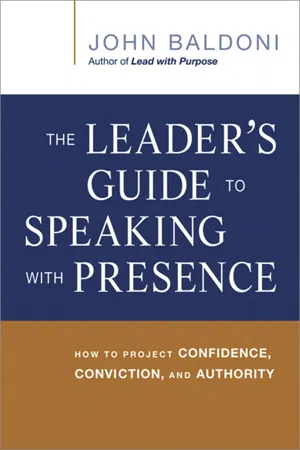
The Leader's Guide to Speaking with Presence
John Baldoni
- 80 páginas
- English
- ePUB (apto para móviles)
- Disponible en iOS y Android
The Leader's Guide to Speaking with Presence
John Baldoni
Información del libro
Whether in a meeting or a presentation, a watercooler conversation or a formal speech, a leader's most important job is to.
Your idea may be groundbreaking. The potential profits might be exhilarating. The time to act may be right now, but if you're not able to craft and deliver a clear message that doesn't lead the audience to gain your perspective, that can be the difference between your pitch being transformational and becoming forgettable.
Executive coach and leadership expert John Baldoni provides this concise tool kit containing more than 100 practical tips for creating and communicating meaningful messages with presence and authority.
In The Leader's Guide to Speaking with Presence, you will discover how to:
- Present their ideas clearly and provide context
- Radiate confidence and put the audience at ease
- Refine their delivery
- Use stories to inform, involve, and inspire
- Leverage the energy of any room
- Convey optimism tempered with reality to gain buy-in
- Turn PowerPoint presentations into performances
When a leader learns to own the room with an authentic and persuasive speech, the audience will become putty in their hands. The Leader's Guide to Speaking with Presence helps leaders achieve the kind of genuine presence that evolves into lasting trust and quantifiable influence.
Preguntas frecuentes
Información
CHAPTER 1
THE SOUND OF YOUR LEADERSHIP SPEECH


SCORING YOUR SPEECH
- Opening. You want to grab the audience's attention. You want to state the purpose of your presentation, that is, what you are going to say and why you are here. Your opening emerges from your content. You may wish to pick out a point to emphasize and lead with it. Don't give away all the details, but you can, as with a musical phrase, give a foretaste of what's to come.
- Pitch. Up and down, crescendo and diminuendo, make music worth listening to. Your voice is your instrument. Sometimes you are loud, other times you are soft. Up and down. If it were all the same tone, it would become boring. Chant, be it Gregorian, Hebrew, or Buddhist, is delivered flatly. That's for spiritual effect. Speeches are a different matter; fluctuation in voice pulls the audience into what you are saying.
- Rhythm. Most importantly, your speech, like music, must be delivered with verve and pace. How often have you heard a piece of music played at the wrong tempo? It sounds awful. The notes may be correct, but if the tempo is off it sounds terrible. As someone who tried to play piano, I can attest to the power of rhythm. Listening to me try to play Gershwin was an exercise in “I ain't got rhythm.” Pacing for a speech is the same. Monotone is deadly, be it slow or fast. We need variation.
- Pause. If you do nothing else in your next speech, pause. Nothing expresses presence like a purposeful pause. The adjective “purposeful” is essential. In music we call them rests or even pauses. They are noted for a reason. A pause could be for emphasis, or it could be for effect, or it could be for reflection. All pauses give your listeners time to reflect on what you are saying. Pauses are powerful.
- Closing. You want to leave them, as great musicians do, wanting more. You want to end on a high. As with your opening, your closing, be it a summary or a call to action, emerges from your content. So you could end with an upbeat and powerful closing, a mighty crescendo. Or you could close with a soft and intimate whisper. Whatever method you choose, make it memorable.
AN ART REDEEMED
ACTION STEPS
- How will you open your presentation on a high note?
- Where might you pause for emphasis?
- How can you make time to rehearse your presentation?
- What are the high notes? What are your points of emphasis?
- What points might you emphasize with a pause?
- How will you close your presentation? Will you tell a story? Or will you issue a call to action?
CHAPTER 2
PRESENT AS A LEADER


- Make personal contact. Look at your audience. Nod at people you know. Smile and relax your facial muscles. Some speakers like to wave at the audience, especially at people they recognize. Size up the audience as you reach the podium. Take a deep breath, pause, and look out at the group. Imagine you are a conductor. Your baton is your voice, but before you raise it, you wait for a beat or two.
- Acknowledge the audience. Before you start speaking, comment on something that everyone in the audience may have in common. It may be the weather. It may be traffic. It may be a busy schedule. Put yourself in the audience's shoes and acknowledge their presence.
- Break the ice. Effective presentations depend on connection. People want to know you, so you have to reveal yourself appropriately. No life stories please, but offer comments on the connection you feel to your audience. If you are comfortable telling a funny story, do so. If you are not, or if the mood is one of solemnity, then speak about the urgency of your message. These comments may seem ad lib, but you can script them in advance to deliver them as if they were off the cuff.
ACTION STEPS
- What will you do to “make friends with the audience”?
- What steps will you take to put them at ease?
- What is a good way for you to “break the ice”? Will you use a story, a comment on the weather, or humor?
CHAPTER 3
MAKE THE AUDIENCE FEEL WELCOME (AND BANISH STAGE FRIGHT)

